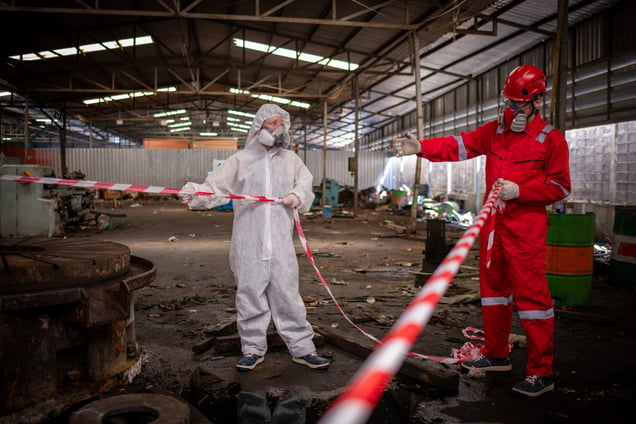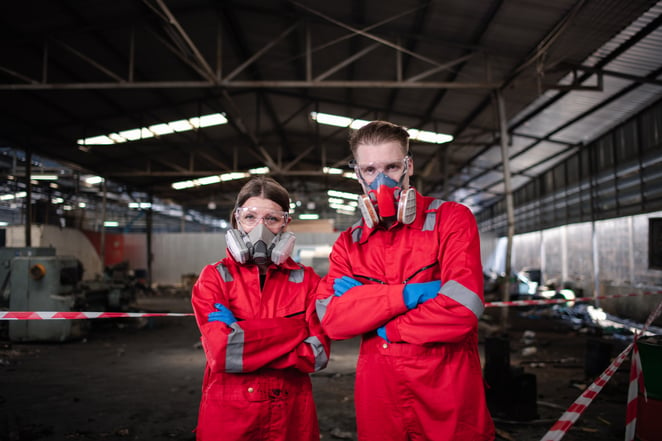When they think of abatement or remediation, most people think of asbestos. The abatement of asbestos is commonly discussed, but other hazardous materials (such as toxic mold) require even more extensive or different measures.
"Abatement" and "remediation" are often used interchangeably in the environmental, health, and safety fields, but these words have different meanings.
Throughout this article, we'll explore the differences between abatement and remediation and explain which approach may be the most appropriate for you.
Abatement
Abatement, such as mold abatement, is the process of removing known hazardous materials from surface areas. In addition to removal, abatement also involves encapsulation, which entails sealing off hazardous materials so that everyone remains safe.
Asbestos, mold, and lead are examples of toxic substances that need an abatement if they are found in a building.
The Abatement Process
The abatement process is fairly straightforward. A certified contractor or company must first identify all areas of the building where hazardous materials are present.
Then, they will create an abatement plan that outlines the steps and equipment needed to safely perform asbestos, lead, or mold removal.
Once this has been established, the contractor will use specialized tools and techniques to safely remove and dispose of the material.
Finally, air quality is tested for toxins, such as asbestos or mold contamination, to make sure that the area is safe for occupancy and use.

Remediation
Meanwhile, the goal of remediation is to reverse, stop, or otherwise eliminate environmental damage so that it doesn't happen again. In addition to abating hazardous materials, this process also takes into consideration the need for planning to make sure the same problem does not occur again.
An effective remedial strategy doesn’t just remove the problem; it also addresses its root cause and puts measures in place to prevent it in the future.
For example, while mold can be handled through an abatement process, it would better to require a remediation process. This is because, unlike asbestos, mold comes from a source problem, such as high humidity levels. Even if mold undergoes abatement; if the source problem (in our hypothetical example, the high humidity levels) isn’t addressed, then the problem will continue to reoccur.
The Remediation Process
The remediation process begins with a full assessment of the situation. This includes identifying the source of a problem (such as mold spores), assessing potential risks to health and safety, and creating a plan that will address all issues related to any hazardous materials.
Once the plan to combat the mold infestation has been created, it is then executed in stages. During each stage, air quality is monitored for its impact on both human health and the environment. Once all hazardous organic material has been removed, the affected area is tested for any remaining contaminants.
This remediation process, such as mold remediation, is then followed by post-remediation testing to make sure that the area is now safe for use and occupancy.
What's the Difference Between Abatement and Remediation?
Abatement and remediation are both effective methods for addressing hazardous materials, but they are used in different scenarios. At a glance, it can seem like remediation is the full package, whereas abatement just removes the material. However, remediation often isn’t needed in certain instances.
Take asbestos, for example. Originally, asbestos was used in many building materials (this was before researchers discovered that long-term exposure to asbestos can cause lung cancer or other sicknesses). That being said, asbestos wasn’t caused by external environmental factors, such as mold. Once asbestos is removed, it doesn’t have a chance to grow and come back. Therefore, no remediation process to prevent it.
On the other hand, remediation is suited to situations where the source of a problem needs to be identified and future risks need to be mitigated. This process, unlike abatement, not only takes into account the removal of hazardous materials but also provides long-term solutions to ensure that the same problem does not occur again.
Factors to Consider When Pursuing Abatement and Remediation
Both abatement and remediation processes need to take these factors into account:
- The type of hazardous material: Different hazardous materials require varying levels of response and care. Asbestos abatement is a common practice due to its health hazards, but other materials, such as lead, may also require abatement or encapsulation.
- Potential risks: In addition to the type of hazardous material, it’s essential to consider potential risks associated with the material. This might include health risks if people are exposed to the material or environmental risks if it is released into the environment.
- Cost: The cost of abatement or remediation will depend on the extent of work needed and the materials required. It’s important to factor costs into the decision-making process as well.
No matter which process you choose, you must make sure that you have a trusted and certified contractor who can safely and efficiently perform abatement or remediation. This will ensure that your hazardous material is safely removed and disposed of in an environmentally sound manner.

Real-Life Applications
So what do abatement and remediation look like in real-life applications?
Often, you'll find remediation in situations where:
- Hazardous materials such as mold growth are found in multiple areas
- The source of the contamination needs to be identified
- Potential risks need to be assessed and managed
- Long-term solutions are necessary
An example of a remediation project is an oil spill cleanup, where not only is the spilled oil removed from contaminated sites and other areas, but plans are also put in place to prevent further issues.
On the other hand, abatement is often used in situations where:
- Hazardous materials are found primarily on the surface of an area, such as asbestos fibers
- No further investigation into the source of contamination is necessary
- The main goal is solely to remove and dispose of any hazardous building materials
Pros and Cons of Abatement vs. Remediation
Pros of Abatement
- Quickly removes hazardous material from surface areas
- Ensures that all hazardous material is safely removed and disposed of
- Cost-effective for small areas
Cons of Abatement
- Does not address the source of a problem or potential risks
Pros of Remediation
- Identifies and addresses the source of a problem
- Evaluates potential health and environmental risks
- Creates long-term solutions to prevent similar problems from occurring again
Cons of Remediation
FAQs

What is common equipment used for the abatement and remediation process?
Common equipment items used for abatement and remediation include air scrubbers, HEPA filters, vacuums, respirators, appropriate personal protective equipment and clothing, and containment enclosures.
What happens if the material tested after abatement or remediation is still not safe?
If the material is still not safe after abatement or remediation, additional steps may need to be taken. This could include further inspection, abatement, or remedial action, as well as additional tests.
The team that is responsible for the abatement or remediation project should assess the situation and come up with a plan of action to ensure that the area is safe for occupancy.
Can you use both abatement and remediation in the same project?
Yes, it is possible to use both abatement and remediation in the same project. Abatement is often used to quickly remove hazardous material from surface areas, while remediation may be used to identify and address the source of a problem or create long-term solutions to prevent similar problems from occurring again.
Does abatement provide long-term protection?
No, abatement does not provide long-term protection because it only removes hazardous material from surface areas. Remediation is better suited for providing long-term protection, as it identifies and addresses the source of a problem and creates long-term solutions to prevent similar problems from occurring again.
Is asbestos abatement always necessary?
Yes, asbestos abatement is always necessary if asbestos is found in a surface area. Abatement will permanently remove the material and make the area safe for use.
What regulations apply to abatement and remediation projects?
The type of regulations that apply to abatement and remediation projects will depend on the type of hazardous material, the location of the property and the project, and other factors. It is important to consult local regulations before beginning any abatement or remediation project.
Are there any risks associated with abatement and remediation?
Yes, there are risks associated with abatement and remediation projects. These risks include health risks if people are exposed to hazardous materials, environmental risks if the material is released into the environment, or worker safety risks if proper precautions are not taken during the project.
It is important to consider potential risks before beginning any abatement or remediation project. Additionally, certified contractors should be used to ensure that all work is performed by industry standards.

Can you do abatement and remediation yourself?
No, it is not recommended that you perform any abatement or remediation projects on your own because they require specialized knowledge and equipment. It is important to hire a certified contractor who can safely and efficiently perform the project by industry standards.
Doing so will ensure that your hazardous material is safely removed and disposed of in an environmentally sound manner.
Final Thoughts
Deciding between abatement and remediation can be difficult, especially if there are potential risks involved.
It’s important to consider all aspects of a project before making a decision, as well as to hire a certified contractor who can safely and efficiently perform the project following industry standards. Taking this step will ensure that hazardous material is safely removed and disposed of.
By understanding the differences between abatement and remediation, you'll be better equipped to choose which process is best for your situation.
0 comments